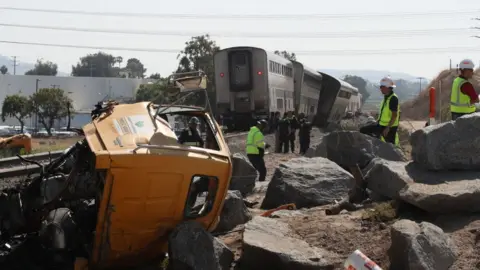
BBC News: Train Crash in the USA – Breaking Updates
| Overview of Train Crashes in the USA |
| Train crashes in the USA, though relatively rare compared to other forms of transportation accidents, still carry significant risks for passengers, crews, and communities. The aftermath of these incidents can be devastating, both in terms of human cost and logistical challenges. BBC News covers these events with in-depth reporting, focusing on the causes, impacts, and responses to these accidents. |
| What Causes Train Crashes? |
| Train crashes can happen due to a variety of factors. Mechanical failures, human error, track issues, and even extreme weather conditions can lead to derailments or collisions. In many cases, it’s a combination of several factors that results in a catastrophic event. The investigation into these causes is crucial for preventing future incidents. |
| Why Are Train Crashes a Concern in the USA? |
| The USA has an extensive rail network, transporting millions of tons of goods and passengers across the country. With so much traffic, the risk of accidents is always present. Additionally, certain areas, particularly those with aging infrastructure, are more prone to accidents. The potential for massive disruption and loss of life makes these incidents a major concern. |
| Recent Train Crashes in the USA |
| In recent years, the USA has experienced several wvpaper.com that have garnered widespread media attention. These crashes highlight ongoing concerns about rail safety and the need for continuous improvements. |
| The 2025 Train Crash in Ohio |
| In early 2025, a tragic train crash in Ohio caused multiple fatalities and left many more injured. The crash, which involved a freight train derailing on a busy stretch of track, disrupted transportation in the region for days. BBC News was on the ground, reporting live updates, including details of rescue efforts and investigation results. |
| The 2024 Pennsylvania Derailment |
| Another notable crash occurred in Pennsylvania in 2024, when a passenger train derailed, causing widespread panic and significant disruption. Emergency services were quickly dispatched to the scene, with over 50 people injured. BBC News followed the event closely, providing timely updates on both the human and logistical impact. |
| The Impact of Train Crashes on Communities |
| When a train crash occurs, its effects are felt beyond the immediate scene. Families are torn apart, infrastructure is damaged, and local economies can take a hit. These crashes often lead to significant emotional and financial strain on affected communities. |
| Casualties and Injuries |
| Train crashes can be deadly. Passengers and crew members often face serious injuries or fatalities. The emotional toll on the survivors, as well as the families of the victims, is immeasurable. In many cases, the recovery process takes years, with physical rehabilitation and emotional support being necessary for many survivors. |
| Disruption to Transportation and Daily Life |
| Aside from the immediate human cost, train crashes also disrupt transportation networks. In many cases, these accidents block major freight and passenger lines, causing delays across the country. The impact can be felt globally as well, especially when critical goods or commodities are delayed. |
| Investigation and Response to Train Crashes |
| When a train crash happens, an immediate response is required. Emergency services, including medical teams and first responders, are typically the first on the scene, followed by investigative bodies such as the National Transportation Safety Board (NTSB). |
| Role of the National Transportation Safety Board (NTSB) |
| The NTSB is an independent federal agency that investigates major transportation accidents, including train crashes. Their job is to determine the cause of the crash and recommend safety improvements. Their reports often reveal underlying issues such as equipment failure, human error, or systemic problems within rail companies. |
| How Authorities Handle the Aftermath |
| In the aftermath of a crash, local and federal authorities work together to assess the damage, provide support to those affected, and determine the best course of action. Recovery efforts often take several days, especially if the crash involves hazardous materials or widespread infrastructure damage. |
| Safety Measures and Improvements in the USA |
| Over the years, the USA has made several efforts to improve rail safety. Technological innovations, improved safety protocols, and infrastructure upgrades are all part of the ongoing effort to reduce the likelihood of future crashes. |
| Technological Innovations for Train Safety |
| One of the most significant advancements in rail safety is the development of Positive Train Control (PTC) systems. PTC is designed to prevent train collisions, derailments, and accidents caused by human error. These systems are being implemented across much of the USA’s rail network to enhance safety. |
| Infrastructure Upgrades to Prevent Crashes |
| Aging infrastructure is a common cause of train crashes. In recent years, there has been a concerted effort to update and maintain the rail network, including replacing outdated tracks, bridges, and signaling systems. These upgrades are crucial for preventing accidents and ensuring the safe operation of trains. |
| The Role of Media in Reporting Train Crashes |
| In the event of a train crash, media outlets play a critical role in disseminating information quickly and accurately. BBC News, known for its comprehensive coverage, provides timely updates on the latest developments and in-depth analysis of the causes and aftermath of train accidents. |
| How BBC News Covers Train Crashes |
| BBC News is known for its detailed and accurate reporting during train crashes. They provide live updates, eyewitness accounts, and expert analysis, helping the public understand the situation and how authorities are responding. Their global perspective ensures that people around the world are informed about these incidents. |
| The Importance of Accurate Reporting in Crisis Situations |
| During crisis events like train crashes, it is essential for the media to provide accurate, clear, and timely information. Misinformation can lead to confusion, panic, and inefficiency in the response efforts. BBC News, with its commitment to accurate reporting, plays a key role in ensuring that people have the correct information during such emergencies. |
| The Future of Rail Safety in the USA |
| As the number of train accidents continues to raise concerns, there is a growing push for stricter regulations and more investment in rail safety. Efforts are being made to reduce the number of crashes and improve overall safety in the rail industry. |
| Are More Stringent Regulations Needed? |
| Some experts believe that the rail industry needs more stringent regulations to ensure safety. This could include more oversight, higher safety standards for equipment, and improved training for train operators. These regulations would help to prevent accidents and improve the overall safety of the rail system. |
| The Push for Better Training and Technology |
| Better training for rail workers and the integration of new technologies are also key to reducing train accidents. The introduction of automated systems, combined with more comprehensive training, could make a significant difference in preventing crashes and improving safety. |
| Conclusion |
| Train crashes are tragic events that cause significant loss and disruption. However, with ongoing improvements in technology, infrastructure, and safety regulations, the USA is taking steps to reduce the likelihood of such accidents. Media outlets like BBC News play a vital role in keeping the public informed, and continued efforts to improve rail safety offer hope for a safer future. |


